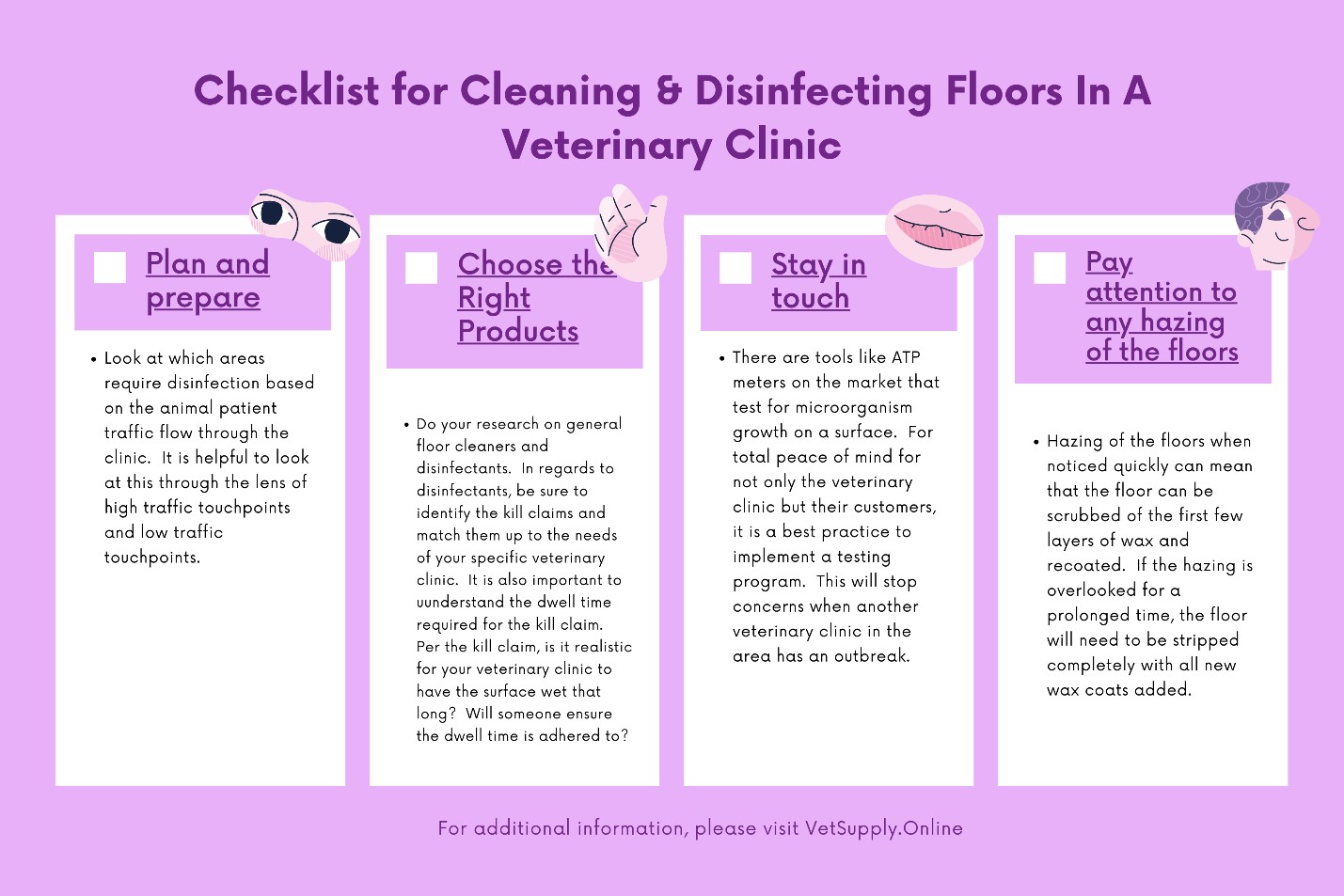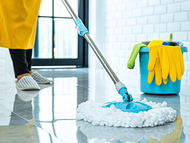Cleaning And Disinfecting Floors In A Veterinary Clinic
1st Aug 2023
Clean, disinfected floors are an important component to the livelihood of a veterinary clinic. An outbreak of parvo in the veterinary clinic, for instance, can be a detriment to the practice not only in the short-term, but also the long-term as negative reviews online can haunt a practice for quite some time after the incident. On the other end of the spectrum, overuse of disinfectants that can leave the floor hazy or even discolored, which when this issue becomes unsightly, can turn off clients – “boy, these floors look [disgusting]. What does the rest of the clinic look like?” And generally speaking, the floors are one of the first things that clients notice walking through the doors.
Let’s look at how a veterinary clinic can maintain both clean, disinfected floors while maintaining the shine.
Creating a Plan
It is important to review the traffic of the animals through the veterinary clinic and think through this traffic in terms of high traffic points and low traffic points. A diagram of the floor layouts can be made, and a determination agreed upon by the leadership can be done as to what will be deemed high traffic areas and low traffic areas. This can then be used to determine which disinfectants are used in which areas; i.e. isolate the use of expensive disinfectants – that carry high kill claims with short contact dwell times – to high traffic touchpoints/areas. For areas of low traffic touch, more general disinfectants can be used.
Disinfectants Do Not Clean
The first point that needs to be made and reinforced is disinfectants do not clean. Repeat: Disinfectants do not clean.
Any visible debris or trash needs to be removed from the surface by mechanical action. By mechanical action – and I hate to get too technical with the jargon here but the visual is important, I mean through the use of a broom, a paper towel, your hand, etc. Then, the floors must be dust mopped.
If the floor surface is easily clearable of furniture in the space, it is highly recommended to use a detergent through an auto scrubber – an auto scrubber around 15” in length will do the trick in most veterinary clinics - to clean the floor surface after dust mopping. Adhere to the instructions on the cleaning chemical’s label through an auto scrubber for the quantity of detergent to use. Please note that there are detergents that double as disinfectants. It is important to review the kill claims against the needs of the veterinary clinic, as well as what the dwell time is for the claim. My recommendation is to separate the steps – use a detergent cleaner, allow the surface to dry, and then apply the desired disinfectant. Why? Separating the steps creates a clear delineation and makes for less confusion and inversely, creates for more optimal outcomes – clean, disinfected floors.
Choosing the Right Disinfectant
When choosing the right disinfectant for your veterinary clinic, first consider what kill claims the products you are reviewing carry. Which of these products carry the kill claims that fit the needs of the veterinary clinic best? Secondly, what is the dwell time of the product for the kill claim? Dwell time is the time that the disinfectant chemical needs to sit on a pre-cleaned surface for the kill claim. Some disinfectants carry a 10-minute dwell time while others carry as little as 60 seconds. As a generalization, the longer the dwell time, the less expensive is the disinfectant. However, if the veterinary clinic has fans blowing, will a disinfectant applied to a surface continue to stay wet for 10 minutes? Will the cleaning personnel actively monitor that dwell times are adhered to? Or, will the person applying the disinfectant wait the needed time per the kill claim?
These are the questions that a veterinary clinic needs to answer in choosing the appropriate disinfectant. For the utmost peace of mind, a veterinary clinic can certainly choose a disinfectant that carries all of the kill claims and the dwell time is the industry best – say, around 60 seconds.

How to Monitor the Program
While eyesight certainly works to a degree in determining whether the floors in a veterinary clinic are clean, for peace of mind to minimize the risk of an outbreak of say Parvo a veterinary clinic should consider implementing an ATP metering system. An ATP metering system is looking for the presence of microorganisms like bacteria. A veterinary clinic would establish a maximum allowed threshold for bacteria found and can set up weekly random inspections of certain key points. These inspections can be logged and tracked. In the event of an outbreak at a veterinary clinic in the area, the veterinary clinic employing ATP metering will have measured proof that they have experienced no issue and/or that protocols are in place to minimize the clinic’s risk.
Monitor the Floors For Hazing
Hazing of polished floors will occur regardless of the use of disinfectants. The one major point of difference is that the use of disinfectants will haze polished floors quicker. Keeping an eye on the hazing of the floor and jumping to action is the major point of concern. The quicker a scrub and recoat can be done after noticing hazing – where only the top few layers of wax are removed from the floor and then only a couple of new layers of wax (generally up to 3) are added, the less likelihood of having to implement the more expensive strip and wax process there is – where all the coats of wax are removed back to the original surface and then 6-8 coats of wax are added.
Conclusion
Maintaining clean, disinfected floors that also look good are important to the health not only of the animal patients at a veterinary clinic but also the health of the business. Positive reviews online help to keep the top-line revenue of the veterinary clinic healthy. Unfortunately, just a handful of negative reviews can really affect the business negatively. So, implementing best practices for cleaning and disinfecting the floors will go a long way to not only making a positive first impression, but ensure the risks associated with an outbreak or minimized to the best extent of the clinic.


